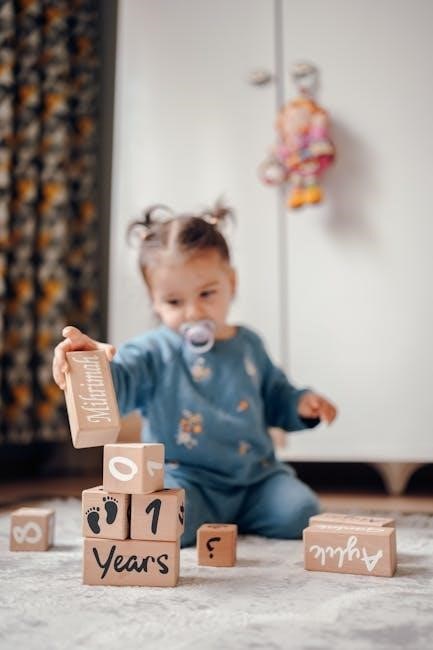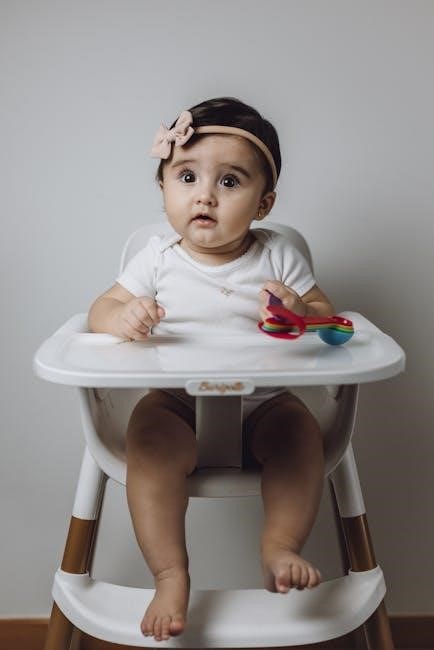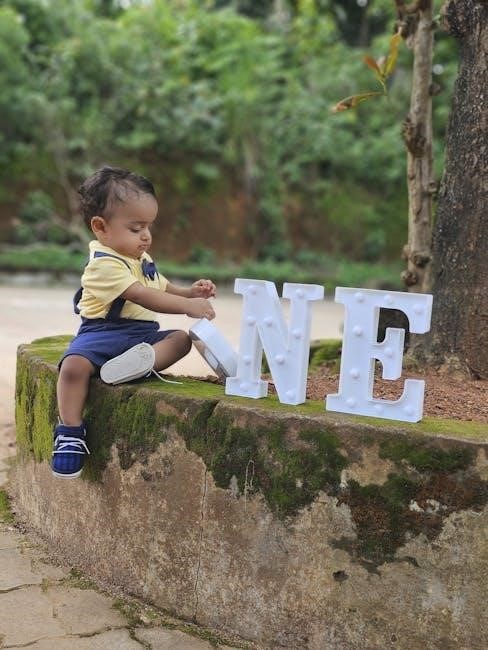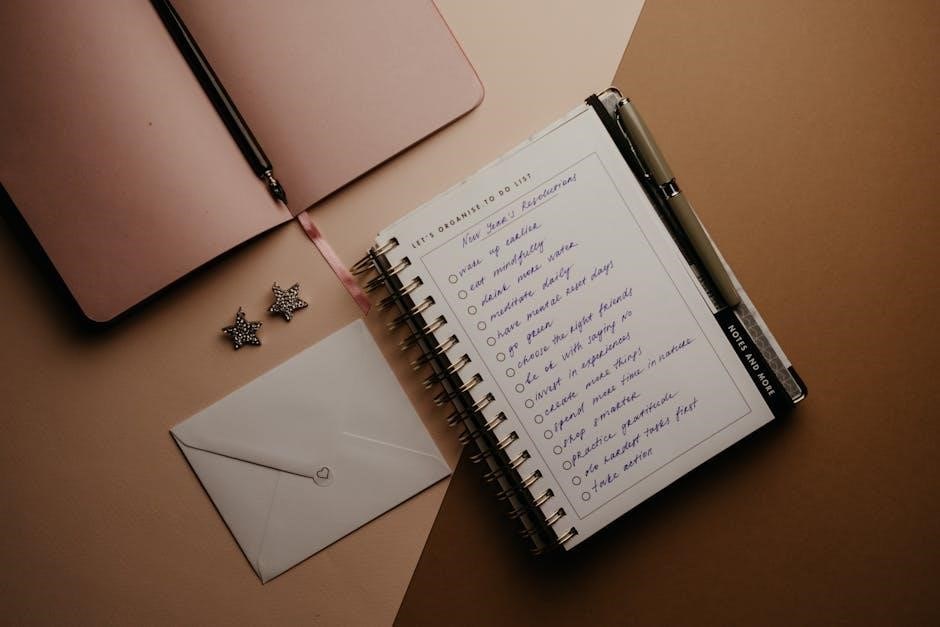The 2-Year-Old Development Checklist is a comprehensive guide to track a child’s growth, covering motor, language, social, and cognitive milestones․ It helps parents and caregivers monitor progress and identify areas needing support, ensuring healthy development․
Overview of Developmental Milestones

Developmental milestones mark typical achievements in a child’s growth, such as motor skills, language, social interactions, and cognitive abilities․ By age 2, most children can run, climb, and kick a ball, demonstrating improved gross motor skills․ Language skills expand, with children combining two words and understanding simple instructions․ Socially, they imitate adults, show affection, and interact with peers․ Cognitive growth includes problem-solving and curiosity about their environment․ These milestones serve as a guide to track progress, ensuring a child’s development aligns with expected timelines․ Understanding these markers helps parents and caregivers support healthy growth and identify potential areas for further support․
Importance of Tracking Development at 2 Years
Tracking developmental milestones at 2 years is crucial for understanding a child’s progress and addressing potential delays early․ It helps identify areas where support may be needed, such as speech, motor skills, or social interactions․ By monitoring milestones, parents and caregivers can provide targeted encouragement and interventions․ This process also ensures that children receive appropriate activities and stimulation to foster healthy growth․ Early detection of delays allows for timely professional guidance, making it a vital tool for promoting optimal development and preparing children for future challenges․ Regular assessment ensures a strong foundation for physical, emotional, and cognitive well-being․
Motor Skills Development
At 2 years, children typically demonstrate improved motor skills, such as kicking a ball, throwing overhand, and climbing․ These abilities reflect their growing physical coordination and strength, enabling exploration and interaction with their environment․ Fine motor skills also advance, with better hand-eye coordination and dexterity in tasks like stacking blocks or using utensils․ Monitoring these milestones helps ensure a child’s physical development is on track for their age․ Early identification of delays can prompt timely interventions to support their growth․ Regular observation of motor skills enhances understanding of a child’s overall developmental progress․ Key areas include balance, movement, and precision tasks․ Consistent practice and encouragement further refine these skills, fostering independence and confidence․ Parents can actively engage in activities that promote motor development, such as play-based exercises and interactive games․ Tracking progress through checklists provides a clear guide for supporting a child’s physical growth․ This stage is critical for building foundational abilities that influence future motor proficiency․ By focusing on these milestones, caregivers can help children achieve key physical achievements, ensuring a strong foundation for lifelong motor skills․ Regular assessment and engagement are vital for optimal development․ Each milestone achieved represents a step toward greater independence and physical competence, highlighting the importance of attentive care and support․ Understanding and nurturing motor skills at this age lays the groundwork for a child’s continued growth and ability to navigate their surroundings effectively․
Gross Motor Skills
Gross motor skills at 2 years include running, kicking, climbing, and jumping․ Children typically demonstrate improved balance and coordination, such as walking on flat ground without support․ They may walk down stairs alone, placing both feet on each step, and climb well․ Throwing a ball overhand and beginning to jump are also common milestones․ These skills reflect their growing physical strength and coordination․ Activities like running games and climbing structures can help enhance these abilities․ Tracking these milestones ensures a child’s motor development is progressing as expected, providing a foundation for more complex movements in the future․ Regular observation and encouragement are key to fostering these essential skills․
Fine Motor Skills
Fine motor skills in 2-year-olds involve precise movements, such as using hands and fingers․ By this age, children often demonstrate abilities like pointing to objects in a book, using at least two prepositions, and saying simple phrases like “More milk․” They may also show improved dexterity, such as holding small objects and attempting to dress themselves․ These skills are essential for tasks like feeding, drawing, and manipulating toys․ Tracking these milestones helps identify areas where support may be needed to ensure healthy development and readiness for more complex activities in the future․

Language and Communication
Language and communication skills in 2-year-olds involve understanding and expressing thoughts․ Children typically use simple sentences, identify objects in books, and engage in basic conversations, fostering social interactions and cognitive growth․
Vocabulary and Word Usage
By age 2, children typically have a vocabulary of around and begin combining two words to form short phrases․ They can identify objects in books when named and start using simple prepositions like “up” or “in․” Stranger’s speech is usually understandable, and they show interest in simple stories․ This stage is crucial for language development, as it lays the foundation for more complex communication skills․ Parents can encourage this growth through interactive conversations, reading, and responding to their child’s attempts to communicate․

Sentence Formation and Communication
At two years old, children begin forming simple sentences, typically using 2- together, like “mama go․” They start combining nouns and verbs but may omit small words like “is” or “the․” Their communication becomes more intentional, and they can describe basic actions or events․ Parents can encourage this by responding to their attempts, expanding their sentences, and modeling correct grammar․ Reading interactive books and engaging in conversations also foster language growth, helping children build foundational communication skills essential for future development․
Social and Emotional Development
At two years old, children often copy others, show affection, and play alongside peers․ They explore emotions, assert independence, and test boundaries, developing social and emotional awareness․

Interaction with Others
At two years old, children begin to interact more purposefully with others, showing curiosity about social dynamics․ They may play alongside peers, imitate adults, and display affection․ While they often prefer parallel play, some may start showing interest in cooperative activities․ Testing boundaries and asserting independence are common, as they explore how to engage with others․ They may also exhibit defiance or resistance as part of learning social limits․ These interactions help build foundational social skills and emotional intelligence, shaping their ability to connect and communicate effectively with others in their environment․
Emotional Intelligence and Expression
At two years old, children start to understand and express a range of emotions, including happiness, anger, and sadness․ They may use words or gestures to convey feelings, though tantrums remain common as they navigate emotional regulation․ Recognizing and responding to others’ emotions, like offering comfort, begins to emerge․ This age marks the start of empathy development, with children showing concern for others․ Play becomes a tool for exploring emotions, helping them process experiences․ Consistent guidance and validation are crucial to fostering healthy emotional growth and self-awareness during this formative stage․

Cognitive Development
At two years old, children explore their environment, showing curiosity and problem-solving skills․ They begin to understand cause-and-effect relationships and demonstrate memory through imitation and simple tasks․
Problem-Solving and Curiosity
At two years old, children often exhibit curiosity and emerging problem-solving abilities․ They explore their environment through trial and error, experimenting with objects and actions․ Simple puzzles, stacking toys, and cause-and-effect games captivate them, fostering cognitive growth․ Toddlers may imitate actions they observe and show interest in figuring out how things work․ This natural curiosity drives learning and memory development․ Encouraging play-based activities that challenge their thinking helps strengthen these skills, preparing them for more complex tasks as they grow․
Understanding Object Permanence
Understanding object permanence is a critical cognitive milestone for 2-year-olds, where they grasp that objects continue to exist even when out of sight․ This concept is demonstrated when a child searches for a hidden toy or remembers where items are placed․ Activities like hide-and-seek or peek-a-boo reinforce this understanding․ By this age, children often exhibit curiosity by seeking hidden objects, showing they comprehend that things don’t disappear permanently․ This skill lays the foundation for memory development and problem-solving abilities, as they begin to mentally track objects and events․ Encouraging games that involve hiding and revealing objects can further enhance this understanding․

Self-Care and Independence
At two years old, children often show interest in self-care activities like feeding and dressing themselves, fostering independence and confidence in daily routines․
Feeding and Dressing
By 24 months, most children demonstrate growing independence in self-care activities․ They can feed themselves using a spoon, though spills may occur, and show interest in dressing themselves․ Many can put on simple clothing like shirts or socks with minimal assistance․ Some may even attempt to fasten buttons or zippers, though fine motor skills may still be developing․ Understanding the purpose of different clothing items, like putting on shoes before going outside, also emerges․ These milestones foster independence and confidence, though some children may still require guidance and patience as they master these skills․
Using the Bathroom Independently
By 24 months, many children show readiness to use the bathroom independently․ They may express the need to go through words or gestures, such as saying “pee” or “poo․” Most can sit on the potty or toilet without assistance and may show interest in wearing underwear․ While accidents are still common, especially when distracted, they often demonstrate improved bladder control․ Parents should encourage consistent routines and praise efforts to foster confidence․ This milestone signifies growing independence and self-awareness, though some children may need more time and support to fully master it․
Safety Guidelines for Parents
Ensure the environment is hazard-free by securing furniture, storing harmful substances, and covering electrical outlets․ Always supervise your child to prevent accidents and injuries, fostering a safe space for exploration and growth․

Creating a Safe Environment
Creating a safe environment for your 2-year-old is essential to prevent accidents and injuries․ Start by securing heavy furniture and appliances to walls to avoid tipping․ Store cleaning supplies, medications, and sharp objects in locked cabinets out of reach․ Use safety gates at stairs and install window guards to prevent falls․ Ensure electrical outlets are covered with tamper-resistant caps, and keep cords or wires out of your child’s reach․ A safe environment allows your child to explore and learn without risks, promoting confidence and independence during this critical developmental stage․
Supervision and Support
Supervision and support are critical for a 2-year-old’s safety and development․ Always monitor your child during play to ensure their environment is free from hazards․ Offer guidance to help them navigate challenges and learn new skills․ Positive reinforcement encourages confidence and independence․ Be patient and responsive to their needs, as they may still require reassurance during exploration․ Consistent support helps them develop self-esteem and emotional resilience, while clear boundaries teach right from wrong․ Supervision also allows you to intervene early if safety risks arise, ensuring they thrive in a protected and nurturing setting․

Activities to Encourage Development
Engage your child in play-based learning, sing songs, and read books to foster creativity and imagination․ Interactive games and hands-on activities promote curiosity and skill development․
Play-Based Learning
Play-based learning is a cornerstone of development for 2-year-olds, fostering creativity, problem-solving, and social skills․ Engage your child in activities like building blocks, pretend play, and sensory exploration to stimulate curiosity․ Reading, singing, and interactive games encourage language development and imagination․ Provide toys that promote hands-on learning, such as puzzles or stacking cups, to refine fine motor skills․ Outdoor play, like running or climbing, enhances gross motor abilities․ Encourage role-playing to build empathy and understanding of social roles․ Play-based learning creates a fun, engaging environment where children can explore, experiment, and grow at their own pace․
Interactive Games and Exercises
Interactive games and exercises are vital for fostering a 2-year-old’s development․ Activities like kicking a ball, throwing overhand, or climbing stairs enhance gross motor skills․ Simple games such as matching shapes or sorting objects improve fine motor dexterity․ Hide-and-seek and role-playing encourage social interaction and emotional intelligence․ Reading aloud and singing songs promote language development and memory․ Encourage curiosity by asking questions and providing opportunities for exploration․ Supervise activities to ensure safety while allowing independence․ These exercises not only entertain but also lay the foundation for future learning, helping your child grow confidently and skillfully․

Tracking Progress and Next Steps
Use the checklist to monitor your child’s development regularly․ Mark observed skills and note areas needing attention․ Celebrate progress and seek professional advice if concerns arise․
Using the Checklist Effectively
The checklist is a valuable tool for monitoring a child’s developmental progress․ Regularly review and update it to track milestones achieved and identify areas needing attention․ Celebrate successes and address delays promptly․ Use the checklist to guide conversations with healthcare providers or educators․ It’s important to remember that every child develops at their own pace, so the checklist should not be seen as a strict measure of success․ Instead, it serves as a guide to support your child’s unique growth journey and ensure they receive the support they need for healthy development․
When to Seek Professional Advice
If your child shows significant delays in reaching milestones or demonstrates concerning behaviors, it’s important to seek professional advice․ For example, if your child is not walking by 18 months, has no words by 16 months, or shows no interest in communication or social interactions, consult a pediatrician․ Additionally, if your child loses previously acquired skills or exhibits persistent emotional distress, professional guidance is recommended․ Trust your instincts and don’t hesitate to discuss any concerns with a healthcare provider․ Early intervention can make a significant difference in supporting your child’s development and addressing any potential challenges effectively․
The 2-Year-Old Development Checklist is a valuable tool for tracking growth and celebrating milestones․ It emphasizes the importance of monitoring progress and providing tailored support to foster healthy development․
By age 2, most children demonstrate significant growth across various domains․ Physically, they can run, climb, and kick a ball․ Language skills expand, with around and simple sentences․ Socially, they interact with peers, show affection, and imitate adults․ Emotionally, they express a range of feelings and may exhibit independence․ Cognitive abilities include problem-solving and understanding object permanence․ While every child develops at their own pace, these milestones provide a general guide to assess progress and identify areas for support․ This summary highlights the key achievements expected around 24 months, offering a clear overview of healthy development․
Encouraging Healthy Growth and Development
Encouraging healthy growth and development in a 2-year-old involves fostering their natural curiosity and providing a nurturing environment․ Engage in daily activities like talking, reading, and playing to stimulate language and cognitive skills․ Offer opportunities for physical exploration, such as climbing or kicking a ball, to enhance motor abilities․ Positive reinforcement and patience are crucial as they learn to navigate independence․ Creating routines for feeding, dressing, and using the bathroom supports self-care development․ By actively participating in your child’s daily life, you help build a strong foundation for their emotional, social, and intellectual growth, ensuring they thrive during this critical stage․
